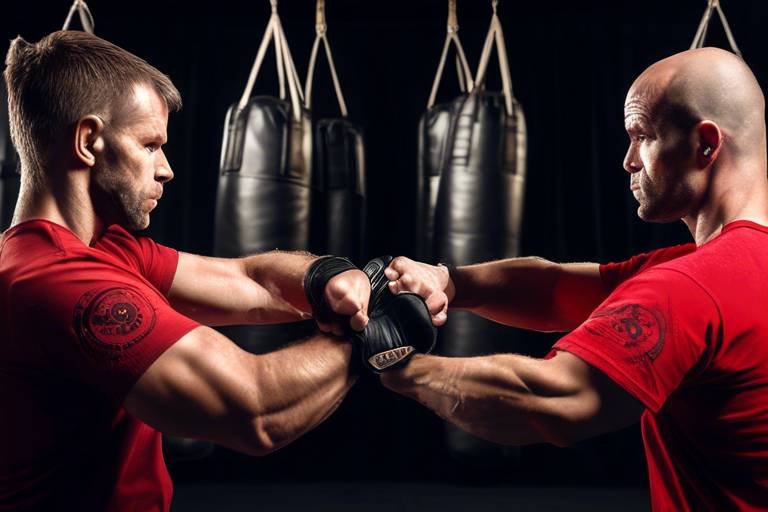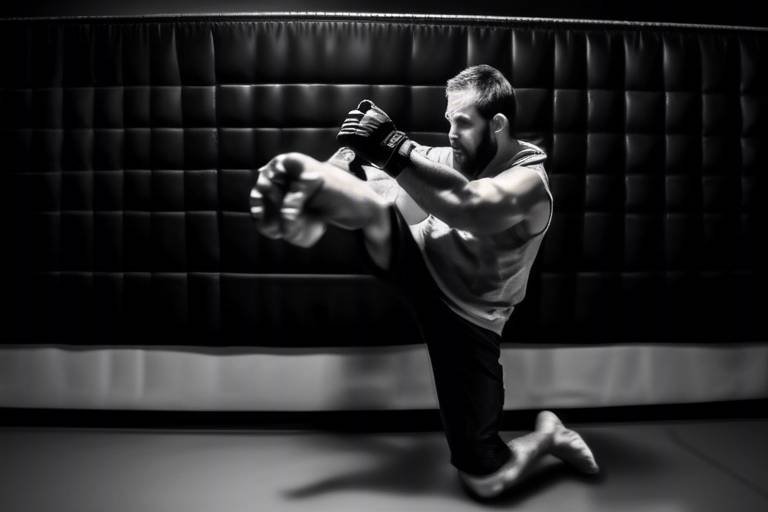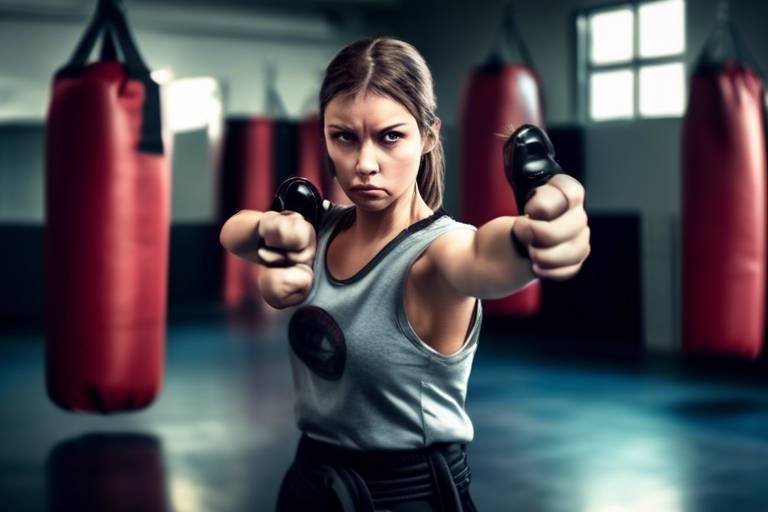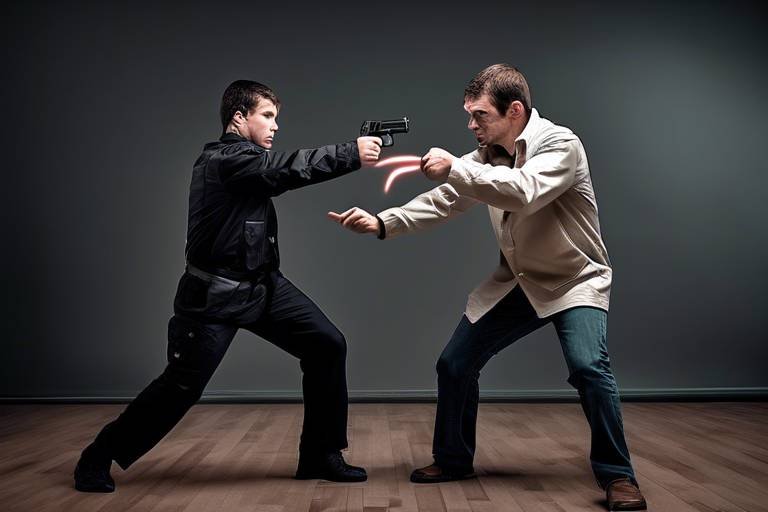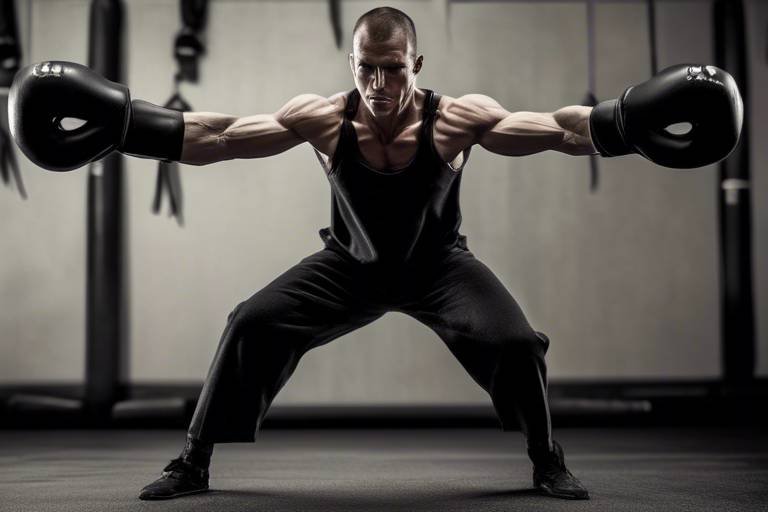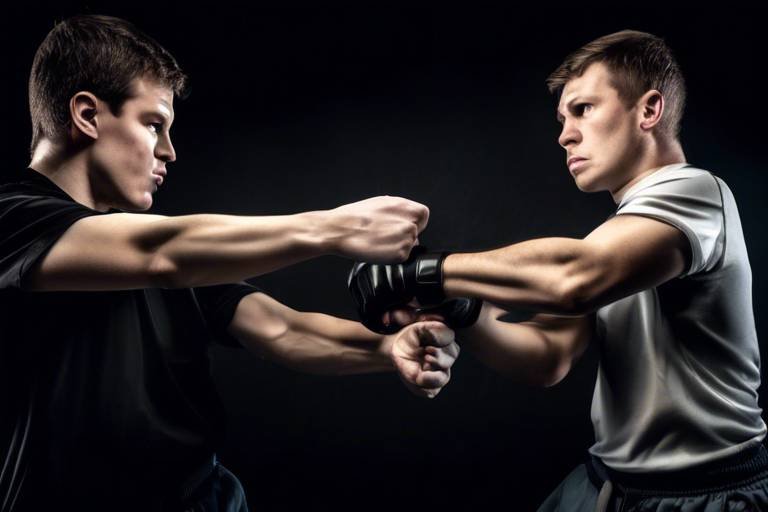Self-Defense Techniques - How Effective are They in Real Life?
When it comes to self-defense, many people wonder just how effective various techniques can be in real-life scenarios. The truth is, self-defense is not just about knowing how to throw a punch or execute a perfect kick; it’s about understanding the dynamics of a situation and being prepared to respond appropriately. Imagine walking down the street and suddenly finding yourself in a threatening situation—what would you do? Self-defense techniques aim to equip you with the skills to handle such moments with confidence and poise.
In this article, we will explore a range of self-defense methods, from martial arts to situational awareness, and evaluate their effectiveness in real-world situations. It's essential to recognize that self-defense is a multifaceted concept that combines physical skills with mental preparation and awareness. By the end of this discussion, you’ll have a clearer understanding of how these techniques work and what you can do to improve your personal safety.
Self-defense is not a one-size-fits-all solution; what works for one person may not work for another. Factors such as size, strength, and even the environment play significant roles in determining the effectiveness of any given technique. For instance, while a larger individual might find success in striking techniques, someone smaller may benefit more from grappling or ground-fighting skills. This diversity in techniques is what makes self-defense a rich field of study.
Moreover, the effectiveness of self-defense techniques is often enhanced by the practitioner's mindset. A confident individual who remains calm under pressure is more likely to react effectively than someone who panics. This psychological aspect is crucial and will be explored further in our discussion. So, whether you're a seasoned martial artist or a complete novice, understanding the various self-defense techniques and their real-life applications can be a game changer.
As we delve deeper into this topic, we will also touch upon the importance of training and practice. Just like any other skill, self-defense requires consistent effort and dedication. You wouldn't expect to become a great musician overnight, right? The same principle applies here. Regular training not only sharpens your skills but also builds the muscle memory needed to react instinctively in a dangerous situation.
In summary, the effectiveness of self-defense techniques in real life is influenced by a combination of physical skills, mental readiness, and situational awareness. By understanding these elements, you can better prepare yourself for any potential threats and enhance your personal safety. Ready to dive into the specifics? Let’s get started!
- What is the best self-defense technique for beginners?
For beginners, techniques that focus on situational awareness and basic escape maneuvers are often the most beneficial. These skills can be learned quickly and can be applied in various situations.
- How often should I practice self-defense techniques?
Regular practice is crucial. Aim for at least one to two sessions per week, along with drills you can do at home to reinforce your skills.
- Is self-defense training expensive?
The cost of self-defense training can vary widely depending on the type of class and location. Many community centers offer affordable options, and there are also online resources available.

Understanding Self-Defense
Self-defense is more than just a physical response to an attack; it encompasses a legal right that allows individuals to protect themselves from harm. This right is grounded in the principles of necessity and proportionality, meaning that the force used in self-defense must be reasonable and necessary to prevent harm. Understanding these principles is crucial for anyone considering self-defense training, as it sets the stage for how one should react in potentially dangerous situations.
At its core, self-defense is about the instinct to survive and protect oneself. Imagine walking down a street and suddenly feeling an uneasy presence behind you. Your heart races, and your mind races even faster, weighing your options. Should you confront the individual? Should you run? This is where the legal and practical aspects of self-defense come into play. The law typically allows individuals to use reasonable force to defend themselves, but what constitutes "reasonable" can vary widely depending on the situation and local laws.
In many jurisdictions, self-defense laws are designed to protect individuals who act in good faith when they believe they are in imminent danger. However, it's essential to understand the nuances of these laws, as they can differ significantly. For instance, some regions may have "stand your ground" laws, allowing individuals to use force without retreating, while others may require a person to attempt to escape the situation first. This can be a bit like navigating a minefield; one wrong step, and you could find yourself in legal trouble.
To further illustrate the importance of understanding self-defense laws, consider the following table that outlines some common self-defense principles:
| Principle | Description |
|---|---|
| Imminence | The threat must be immediate and unavoidable. |
| Proportionality | The level of force used must match the threat faced. |
| Reasonableness | A reasonable person in the same situation would feel threatened. |
| Duty to Retreat | In some jurisdictions, one must attempt to escape before using force. |
Understanding these principles helps individuals not only to prepare physically but also mentally for the challenges of self-defense situations. It’s like preparing for a big exam; the more you know about the subject, the better you can perform under pressure. Moreover, being aware of the legal implications can empower you to make informed decisions when faced with dangerous situations.
Ultimately, self-defense is about personal safety and empowerment. It’s an essential skill set that goes beyond the physical techniques learned in classes; it’s about fostering a mindset that prioritizes awareness and readiness. By understanding the laws and principles of self-defense, individuals can navigate their environments with confidence, knowing that they have the tools to protect themselves if necessary.

Popular Self-Defense Techniques
When it comes to self-defense, the choices can feel overwhelming. You might be asking yourself, "Which technique is best for me?" or "What should I focus on?" The truth is, there are several popular self-defense methods, each tailored to different situations and personal preferences. Understanding these techniques can empower you to make informed decisions about your safety. Let's dive into some of the most effective self-defense techniques that have gained popularity over the years.
One of the most prominent techniques is Krav Maga. Originally developed for the Israeli military, Krav Maga is all about practicality and efficiency. It focuses on real-world scenarios, teaching individuals how to defend themselves against armed and unarmed attackers alike. The beauty of Krav Maga lies in its simplicity; the techniques are designed to be instinctive, allowing individuals to react quickly in high-pressure situations. This system emphasizes aggression, making it a popular choice for those who want to feel empowered and ready to face any threat.
Another technique gaining traction is Brazilian Jiu-Jitsu (BJJ). This martial art focuses on ground fighting and submission techniques. Its primary aim is to enable a smaller, weaker person to defend against a larger opponent by using leverage and technique. In a self-defense scenario, BJJ teaches you how to control an opponent without relying on strikes, which can be particularly useful in situations where physical confrontation is unavoidable. Imagine being able to neutralize a threat without escalating the violence—BJJ provides that skill set.
Additionally, traditional martial arts, such as Karate and Tae Kwon Do, have their own unique contributions to self-defense. These disciplines not only teach physical techniques but also instill a sense of discipline and respect. They often incorporate forms (katas) that help practitioners develop muscle memory and mental focus, which can be incredibly beneficial in a self-defense context. However, it’s essential to note that while these martial arts can be effective, their real-world application may vary based on the situation and the practitioner's ability to adapt.
To give you a clearer picture of these techniques, here’s a quick comparison:
| Technique | Focus | Best For |
|---|---|---|
| Krav Maga | Real-world scenarios, aggressive defense | Quick reactions in high-pressure situations |
| Brazilian Jiu-Jitsu | Ground fighting, submissions | Controlling an opponent without striking |
| Traditional Martial Arts | Discipline, forms, striking | Building confidence and respect |
Ultimately, the effectiveness of these self-defense techniques will depend on your personal preferences, physical abilities, and the specific situations you might encounter. It's crucial to explore and even try out different classes to find the one that resonates with you the most. Remember, self-defense is not just about learning how to fight; it's about understanding how to protect yourself and stay safe in any environment.

Martial Arts Overview
When we talk about martial arts, we're diving into a world rich with history, culture, and purpose. Martial arts are not just about throwing punches or executing high kicks; they embody a philosophy that promotes discipline, respect, and self-improvement. Each style of martial art carries its own unique techniques and principles, which can be incredibly beneficial for self-defense. Think of martial arts as a toolbox—each tool has its specific use, and depending on the situation, one might be more effective than the others.
At their core, martial arts teach practitioners how to defend themselves while also fostering a sense of confidence and empowerment. Many people find that training in martial arts not only enhances their physical abilities but also sharpens their mental acuity. It's like learning to ride a bike; at first, it seems daunting, but once you find your balance, the world opens up in ways you never imagined. The same applies to martial arts; with practice, you develop skills that can be life-changing.
There are several popular styles of martial arts that people often pursue for self-defense, including:
- Krav Maga: A practical and efficient system developed for the Israeli military, focusing on real-world scenarios.
- Brazilian Jiu-Jitsu: A ground fighting technique that emphasizes submission and control, allowing a smaller person to defend against a larger opponent.
- Karate: A striking art that teaches powerful punches and kicks, as well as discipline and respect for others.
- Taekwondo: Known for its dynamic kicking techniques, it also emphasizes mental discipline and physical fitness.
Each of these styles has its unique approach to self-defense, making it crucial for individuals to choose a discipline that resonates with them personally. For instance, if you prefer a more aggressive, no-holds-barred approach, Krav Maga may be your best bet. On the other hand, if you want to focus on grappling and leverage, Brazilian Jiu-Jitsu could be the way to go.
Moreover, learning martial arts can significantly improve your situational awareness. As you train, you become more attuned to your surroundings and better equipped to recognize potential threats before they escalate. It's like having an internal radar that helps you navigate through life with a greater sense of security.
In conclusion, martial arts are more than just a series of techniques; they are a holistic approach to self-defense and personal growth. Whether you're looking to build confidence, improve your physical fitness, or learn how to protect yourself, martial arts offer a multifaceted solution that can enhance your life in numerous ways.

Krav Maga
Krav Maga is not just another martial art; it's a dynamic self-defense system that was developed for the Israeli military. Its primary focus is on real-world situations, making it a practical choice for those looking to defend themselves against various threats. What sets Krav Maga apart is its emphasis on instinctive movements and the ability to respond quickly under pressure. Unlike traditional martial arts that often include complex techniques, Krav Maga teaches you to react with speed and efficiency, utilizing natural reflexes to counter attacks.
One of the core principles of Krav Maga is its adaptability. Practitioners learn to defend against a wide range of attacks, from armed assaults to multiple attackers. This versatility is crucial because, in a real-life scenario, you may not have the luxury of time to think through your options. Instead, Krav Maga trains you to assess the situation and respond appropriately, whether that means escaping the threat or neutralizing it. The training often includes scenarios that simulate real-life confrontations, which helps build the muscle memory necessary for effective defense.
Moreover, Krav Maga incorporates both offensive and defensive techniques, meaning you won't just learn how to block or evade an attack; you'll also learn how to counterattack effectively. This is particularly empowering, as it enables individuals to take control of their safety rather than just reacting to threats. The system teaches you to target vulnerable areas of an attacker, such as the eyes, throat, and groin, maximizing your chances of escaping a dangerous situation.
Another significant aspect of Krav Maga is its focus on mental preparedness. Practitioners are taught to maintain a strong mindset, which is crucial during high-stress situations. This mental training helps individuals manage fear and anxiety, enabling them to make quick decisions when it matters most. In essence, Krav Maga is about more than just physical defense; it's about cultivating a warrior mentality that empowers you to face challenges head-on.
In summary, Krav Maga is a highly effective self-defense system that prepares individuals for real-life confrontations. With its focus on instinctive reactions, practical techniques, and mental fortitude, it's an excellent choice for anyone looking to enhance their personal safety. Whether you're a beginner or have some experience in martial arts, Krav Maga offers valuable skills that can make a significant difference in your ability to defend yourself.

Brazilian Jiu-Jitsu
Brazilian Jiu-Jitsu (BJJ) is more than just a martial art; it's a powerful self-defense system that emphasizes technique over brute strength. Originating from the traditional Japanese jiu-jitsu, BJJ has evolved into a unique discipline that focuses on ground fighting and submission grappling. Imagine being able to control an opponent without throwing a single punch! This is the essence of BJJ, where leverage and technique become your greatest allies.
One of the standout features of Brazilian Jiu-Jitsu is its effectiveness in real-life self-defense situations. The ability to neutralize an aggressor, regardless of their size or strength, is what makes BJJ particularly appealing. For instance, if you're taken to the ground during a confrontation, knowing how to maneuver and submit your opponent can turn the tide in your favor. This is crucial because many street fights end up on the ground, and having the skills to defend yourself in such scenarios can be a game-changer.
In BJJ, practitioners learn to use their bodies efficiently. The techniques focus on joint locks and chokeholds that can incapacitate an opponent without causing permanent harm. This is not just about fighting; it’s about understanding body mechanics and utilizing them to your advantage. Here’s a quick breakdown of some key principles:
| Principle | Description |
|---|---|
| Leverage | Using body weight and positioning to control an opponent. |
| Technique over Strength | Focusing on skillful execution rather than raw power. |
| Positional Control | Maintaining superior positions to dictate the engagement. |
Moreover, Brazilian Jiu-Jitsu is not only about physical skills; it also fosters mental resilience. Practitioners often find themselves in challenging situations during training, which helps develop problem-solving skills and the ability to stay calm under pressure. This mental toughness is invaluable, as it translates into everyday life, allowing individuals to handle stressful situations more effectively.
As you can see, Brazilian Jiu-Jitsu is a comprehensive self-defense system that equips individuals with both the physical and mental tools necessary to protect themselves. Whether you're a seasoned martial artist or a complete beginner, the principles of BJJ can be adapted to fit your needs, making it an excellent choice for anyone interested in self-defense.
- Is Brazilian Jiu-Jitsu suitable for beginners? Absolutely! BJJ classes are designed to accommodate all skill levels, and beginners are always welcome.
- Do I need to be in shape to start training? Not at all. BJJ is a great way to get in shape, and many practitioners find that they improve their fitness levels as they train.
- How long does it take to become proficient in BJJ? Proficiency varies by individual, but consistent training over several months can lead to noticeable improvements.

Situational Awareness
When it comes to self-defense, situational awareness is your best friend. Imagine walking down a street, earbuds in, completely absorbed in your playlist. You might be blissfully unaware of the person lurking behind you or the group of individuals that are acting suspiciously. This is where situational awareness comes into play—it’s all about being conscious of your environment and the potential threats that may exist within it. It's not just about being alert; it's about actively engaging with your surroundings and understanding the dynamics at play.
Being aware of your surroundings can significantly enhance your ability to respond to potential threats. It’s like having a sixth sense that helps you navigate through life’s uncertainties. You might ask, "How do I develop this sixth sense?" Well, it starts with a few simple practices:
- Observe: Take a moment to scan your environment. Look for exits, potential hiding spots, and people who may be acting out of character.
- Listen: Pay attention to sounds around you. Unusual noises or raised voices can be indicators of trouble.
- Trust Your Gut: If something feels off, it probably is. Don't dismiss your instincts; they are often your first line of defense.
Situational awareness is not just about identifying threats; it also involves understanding the context of your surroundings. For example, if you’re in a crowded place, it’s essential to recognize that while most people are harmless, the sheer number of individuals can create opportunities for someone with bad intentions. By staying alert and aware, you can spot unusual behavior and react accordingly before a situation escalates.
Furthermore, situational awareness can also help in de-escalating potential confrontations. If you notice someone who seems agitated or aggressive, maintaining a calm demeanor and avoiding eye contact can sometimes diffuse the tension. It’s like being a skilled chess player—anticipating moves and reacting in a way that keeps you safe.
Incorporating situational awareness into your daily life doesn’t have to be a chore. It can be as simple as making it a habit to look up from your phone and engage with the world around you. Whether you’re in a parking lot, at a café, or even in your own neighborhood, being mindful of your environment can be a game changer. This heightened awareness can empower you to take proactive measures, whether that means crossing the street to avoid a suspicious individual or simply being prepared to react quickly if necessary.
In a nutshell, situational awareness is about being present, observant, and responsive. It’s a skill that anyone can develop, and it can make a significant difference in your personal safety. So, the next time you step out, remember to engage with your environment. It could be the difference between a safe outing and a dangerous encounter.
- What is situational awareness? Situational awareness is the ability to perceive and understand your surroundings, allowing you to identify potential threats and respond appropriately.
- How can I improve my situational awareness? You can improve your situational awareness by practicing observation, listening to your environment, and trusting your instincts.
- Is situational awareness only important for self-defense? While it is crucial for self-defense, situational awareness is also valuable in everyday life, helping you navigate various social and environmental situations safely.

Training for Self-Defense
When it comes to self-defense, training is not just an option; it's a necessity. Think of it as preparing for a big game or an important presentation—you wouldn't go in unprepared, right? The same principle applies here. Proper training equips you with the skills and confidence to handle potentially dangerous situations. But what does effective training look like? Well, it can take various forms, from traditional classes to online resources, and even practice drills at home. Each method has its unique benefits, and understanding these can help you choose the best approach for your needs.
First off, let's talk about traditional self-defense classes. These are often led by experienced instructors who can provide personalized feedback and guidance. In a class setting, you get to learn alongside others, which can create a supportive environment. Plus, practicing techniques with a partner helps simulate real-life scenarios, making your training more effective. Not to mention, the camaraderie built in these classes can be a huge motivational boost. However, it's essential to find a class that resonates with you personally. Look for instructors who emphasize practical skills over flashy techniques, as this focus will better prepare you for real-world situations.
If traditional classes don't fit into your schedule or budget, don't worry! The digital age has made it easier than ever to access quality self-defense training online. There are countless video tutorials, webinars, and even virtual classes available at your fingertips. These resources can be incredibly useful for learning the basics or refining specific techniques. Just remember, while online training can be a great supplement, it shouldn't completely replace in-person training. The lack of physical interaction can make it challenging to grasp certain concepts fully.
Now, let's not forget about the importance of consistent practice. Just like learning a musical instrument or a new language, repetition is key to mastering self-defense techniques. Set aside some time each week to practice what you've learned. This could be as simple as shadowboxing in your living room or practicing specific moves with a friend or family member. The more you drill these techniques, the more they become second nature. It's all about building that all-important muscle memory, which can make a world of difference in a high-pressure situation.
To help you get started, here’s a quick table summarizing different training options:
| Training Option | Description | Pros | Cons |
|---|---|---|---|
| Traditional Classes | In-person training with an instructor | Personalized feedback, partner practice | Time and cost commitments |
| Online Resources | Video tutorials and virtual classes | Flexible, accessible | Lack of physical interaction |
| Practice Drills | Solo or partner drills at home | Convenient, reinforces skills | Requires self-discipline |
In conclusion, no matter which training method you choose, the key is to remain committed and open to learning. Self-defense is a journey, not a destination. The more you invest in your training, the better prepared you'll be to handle any situation that comes your way. So, lace up those shoes, grab a friend, or log onto your favorite online platform, and start honing those skills!

Choosing the Right Class
When it comes to selecting a self-defense class, the choices can feel overwhelming. With so many options available, how do you know which one is right for you? Choosing the right class is crucial not just for learning effective techniques, but also for ensuring that you feel comfortable and confident in your training environment. Here are some key factors to consider:
First and foremost, research the instructors. A good instructor is not just skilled in self-defense techniques; they should also be able to teach effectively. Look for instructors who have credible backgrounds, certifications, and experience in teaching self-defense. It’s beneficial to read reviews or testimonials from former students to gauge their teaching style and effectiveness.
Next, consider the class size. Smaller class sizes often allow for more personalized attention, which can be particularly helpful for beginners. In a smaller setting, instructors can provide immediate feedback and corrections, enhancing your learning experience. On the other hand, larger classes might offer a more diverse range of techniques and perspectives but can sometimes dilute individual attention.
Another important aspect is the curriculum. Different self-defense classes focus on various techniques and philosophies. For instance, if you’re interested in practical, real-world applications, a class that specializes in Krav Maga might be ideal. Conversely, if you prefer grappling and ground techniques, Brazilian Jiu-Jitsu could be the way to go. Always ask about what techniques are covered and how they relate to real-life scenarios.
Don’t forget to assess the training environment. A welcoming and supportive atmosphere can make a significant difference in your learning experience. Attend a trial class if possible to get a feel for the culture of the school. Are students encouraging each other? Is the instructor approachable? These factors can greatly influence your motivation and enjoyment of the class.
Lastly, consider your personal goals. Are you looking to learn self-defense for personal safety, fitness, or competition? Being clear about your objectives will help you choose a class that aligns with your aspirations. For example, if your primary goal is to build confidence and learn practical self-defense, look for classes that emphasize situational awareness and real-life scenarios.
In summary, choosing the right self-defense class involves careful consideration of various factors, including instructor qualifications, class size, curriculum focus, training environment, and your personal goals. By taking the time to find a class that fits your needs, you’ll be setting yourself up for success on your self-defense journey.
- What should I wear to a self-defense class?
Comfortable athletic clothing and closed-toe shoes are recommended. Avoid jewelry that could get caught during training. - How long will it take to learn self-defense?
The timeline varies depending on the individual and the class. Regular practice is key, and many people start to feel more confident within a few weeks. - Is self-defense training only for women?
No, self-defense training is beneficial for everyone, regardless of gender, age, or physical ability. - Do I need to be in shape to start self-defense classes?
No, self-defense classes can accommodate all fitness levels. Many classes focus on building strength and endurance as part of the training.

Practice and Repetition
When it comes to mastering self-defense techniques, are your best friends. Think about it: just like learning to ride a bike or play a musical instrument, the more you practice, the more natural it becomes. Regularly drilling your self-defense moves helps to build muscle memory, allowing you to react instinctively in high-pressure situations. Imagine being in a scenario where you need to defend yourself; the last thing you want is to freeze up or hesitate because you're unsure of your skills.
So, how do you incorporate effective practice into your routine? Start by setting aside dedicated time each week to focus solely on self-defense. This could be in the form of attending classes, practicing with a partner, or even solo drills. It's essential to keep your training varied to maintain your interest and challenge your abilities. For instance, you might want to alternate between striking techniques one day and grappling techniques the next. This approach not only keeps things fresh but also ensures that you are well-rounded in your skill set.
Moreover, practicing in different environments can significantly enhance your adaptability. Consider the following tips for effective practice:
- Consistency is Key: Aim for at least two to three practice sessions per week. Consistency will help reinforce your skills and keep them sharp.
- Focus on Technique: Don’t just go through the motions. Pay attention to your form and technique, as this will make a significant difference in your effectiveness.
- Simulate Real-Life Scenarios: Try to practice your techniques in scenarios that mimic real-life situations. This could involve role-playing with a partner or using training equipment like pads or dummies.
- Seek Feedback: Don’t hesitate to ask for feedback from instructors or peers. Constructive criticism can help you identify areas for improvement.
In addition to physical practice, mental rehearsal can also be beneficial. Visualizing yourself executing techniques successfully can enhance your confidence and prepare your mind for actual encounters. Research shows that mental practice can activate the same neural pathways as physical practice, making it a valuable tool in your self-defense arsenal.
Lastly, remember that self-defense is not just about physical techniques; it's about building a mindset of confidence and awareness. The more you practice, the more you will internalize the principles of self-defense, allowing you to respond effectively when it matters most. So, get out there, practice diligently, and empower yourself with the skills you need to stay safe!
1. How often should I practice self-defense techniques?
It's recommended to practice at least two to three times a week to build muscle memory and confidence.
2. Can I practice self-defense alone?
Yes, many techniques can be practiced solo, such as shadow fighting or using training equipment like bags. However, practicing with a partner is beneficial for learning timing and distance.
3. What should I focus on during practice?
Focus on proper technique, consistency, and simulating real-life scenarios to enhance your skills effectively.
4. Is mental rehearsal effective for self-defense?
Absolutely! Visualizing your techniques can help reinforce your skills and prepare your mind for real-life situations.

The Psychological Aspect of Self-Defense
When we think about self-defense, our minds often jump to physical techniques and martial arts moves. However, it’s crucial to understand that the psychological aspect plays a significant role in the effectiveness of self-defense. Imagine being in a high-pressure situation; your body might be ready to fight or flee, but what about your mind? It’s like having a well-tuned engine but forgetting to check the fuel gauge. Without the right mental preparation, even the best techniques can falter.
First and foremost, having the right mindset is essential. A positive and assertive attitude can make a world of difference. Think of it as a shield against fear. When you believe in your ability to defend yourself, you’re more likely to act decisively when it matters most. This confidence can deter potential attackers, as they often look for easy targets. If you project strength and awareness, you may just avoid confrontation altogether.
Another critical psychological factor is fear management. It’s natural to feel fear in dangerous situations, but how you handle that fear can determine the outcome. Training can help you develop techniques to control your fear response. For instance, deep breathing exercises can ground you during a panic moment. Picture this: you’re confronted in a dark alley, and instead of freezing in fear, you take a deep breath, assess your surroundings, and prepare your response. This ability to stay calm under pressure is invaluable.
Moreover, decision-making under pressure is a skill that can be honed through practice. In self-defense scenarios, you often have split seconds to make choices. Training helps you become familiar with various situations, enabling quicker and more effective responses. Think of it like a chess game; the more you play, the better you understand the moves. You start to recognize patterns and anticipate what might happen next.
To illustrate the importance of these psychological aspects, let’s take a look at a simple table comparing physical skills and mental preparation:
| Aspect | Physical Skills | Mental Preparation |
|---|---|---|
| Focus | Requires physical training and practice | Involves concentration and awareness |
| Response Time | Improved through drills and techniques | Quick decision-making under stress |
| Confidence | Built through physical competence | Developed through mental conditioning |
| Fear Management | Physical readiness to fight or escape | Techniques to control anxiety and fear |
Ultimately, self-defense is a holistic practice. It’s not just about throwing punches or executing a perfect kick; it’s about preparing your mind as much as your body. So, the next time you consider self-defense training, remember to focus on both aspects. Engaging in mental conditioning exercises, such as visualization techniques, can enhance your ability to react effectively. Picture yourself successfully defending against an attacker; this mental rehearsal can make a significant difference when faced with real-life threats.
In conclusion, the psychological aspect of self-defense is as vital as the physical techniques you learn. By cultivating a strong mindset, managing fear, and honing decision-making skills, you can significantly increase your chances of successfully defending yourself in a crisis. So, gear up not just physically, but mentally, because in the world of self-defense, your mind is your most powerful weapon.
- What is the most important aspect of self-defense? Both physical skills and mental preparation are crucial. A balanced approach enhances your overall effectiveness.
- Can I learn self-defense online? Yes, many resources are available online, but practical training with an instructor is highly recommended for hands-on experience.
- How can I manage fear during an attack? Practice deep breathing and visualization techniques to help control your fear response in high-pressure situations.
Frequently Asked Questions
- What is self-defense?
Self-defense is the legal right to protect oneself from harm. It's not just about physical techniques; it's about understanding the principles and laws that allow you to defend yourself effectively while staying within legal boundaries.
- How effective are self-defense techniques in real-life situations?
Self-defense techniques can be highly effective, but their success often depends on the situation and the individual's training. Techniques like Krav Maga focus on real-world scenarios, making them practical for unexpected confrontations.
- What are some popular self-defense techniques?
Some of the most popular self-defense techniques include Krav Maga, Brazilian Jiu-Jitsu, and traditional martial arts. Each method has its unique approach, whether it's striking, grappling, or a combination of both, catering to different self-defense needs.
- Do I need to be physically strong to learn self-defense?
No, physical strength is not a requirement for learning self-defense. Many techniques focus on leverage, technique, and situational awareness rather than brute strength, making them accessible to individuals of all fitness levels.
- How do I choose the right self-defense class?
When selecting a self-defense class, consider factors like the instructor's credentials, the class size, and the techniques taught. Look for classes that emphasize practical training, real-life scenarios, and a supportive learning environment.
- Is situational awareness important for self-defense?
Absolutely! Situational awareness is crucial for preventing dangerous situations. By being aware of your surroundings, you can avoid potential threats and respond more effectively if a confrontation arises.
- How often should I practice self-defense techniques?
Regular practice is key! Aim for consistent training sessions to reinforce your skills and build muscle memory. Even short, frequent practice can significantly improve your confidence and effectiveness in real-life situations.
- What role does psychology play in self-defense?
The psychological aspect of self-defense is vital. A strong mindset, effective fear management, and quick decision-making under pressure can greatly influence the outcome of a self-defense situation.
- Can self-defense training help with confidence?
Yes! Self-defense training not only equips you with practical skills but also boosts your confidence. Knowing you can protect yourself can empower you in everyday situations, making you feel more secure and self-assured.





